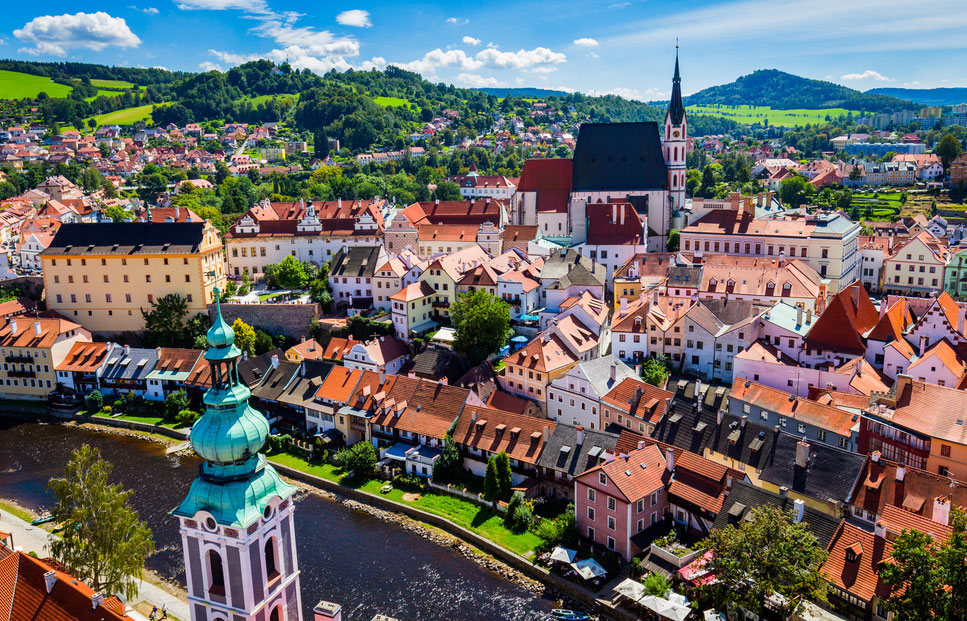Cesky Krumlov, a medieval jewel in the Czech Republic


Cesky Krumlov is a medieval jewel located in the southern region of the Czech Republic (South Bohemia), thanks to its fairytale castle and its hundreds of houses, it has been listed by UNESCO as a World Heritage Site.
The amazing thing about this city is not only its preserved medieval architecture, but its settlement on a meander of the Vltava River that makes the city a true labyrinth of streets and makes orientation an authentic challenge.
What to see in Cesky Krumlov?
Cesky Krumlov Castle

Cesky Krumlov Castle is the second largest in the country after Hradčany Castle in Prague.
Its construction dates from the thirteenth century when the Rosenberg decided to raise this fortress (originally Gothic). The castle would reach its maximum splendor between the seventeenth and eighteenth centuries under the rule of the Schwarzenberg family, who rebuilt it with a more Renaissance style.
Cesky Krumlov Castle Museum

In the Castle Museum you can see exhibition objects such as portraits of the different families that have inhabited the castle, costumes or recreations of the rooms inside the castle with objects from the Schwarzenberg period, mainly.
Artifacts from all eras and even other parts of the world are preserved in the weapons room, such as some African shotguns that were gifts for governors.
They also highlight the ecclesiastical relics, among which is the body of San Reparat, and some board games of the time such as chess.
At the end of the tour we find a movie theater that plays movies made in the twentieth century by members of the Schwarzenberg family and objects related to the history of cinema that had been stored in the castle’s deposits until recently.
Cesky Krumlov Castle Tower

The castle already offers impressive views of the city, but without a doubt the best views can be enjoyed from the top of its colorful bell tower that allows you to get a panoramic view of 360º.
This tower is the most emblematic symbol of Cesky Krumlov and can be seen from practically all points of the city.
Cesky Krumlov Castle Gardens

The baroque gardens of the castle date from the 17th century. You can visit freely and if you have time to lose yourself among its labyrinthine paths, its French and English gardening, and its stone fountains, they have an area of almost eleven hectares.
Cesky Krumlov Old Town

The medieval buildings of the old town of Cesky Krumlov have preserved their Gothic, Renaissance and Baroque elements for hundreds of years.
The colorful facades decorated with wooden windows and balconies make you move completely to another era.
At the foot of the street hundreds of establishments, souvenir shops and restaurants keep the bustle of people alive throughout the day and, therefore, the inhabitants prefer to live on the second floors.
Getting lost without a map through the streets of Cesky Krumlov is the best way to discover the most hidden corners of the city that not only awaits medieval constructions but also leaves a lot of space for contemporary art.
Church of San Vito

The Church of San Vito is a Gothic building dating from the fifteenth century. It was built on the foundations of an older building of the year 1309 and during the 17th and 18th centuries it has been extended and modified several times.
Torture Museum

The exhibition is located in some old wineries that have been rebuilt under the city hall, which already gives the matter a very gloomy atmosphere. In addition, throughout the tour accompanies a very disturbing soundtrack that also puts you in a situation.

In the first part only the torture instruments and some engravings are shown, but in the second part the torture scenes are recreated with wax dolls that together with the effects of sounds and the play of lights make the experience quite disturbing.
Cesky Krumlov Viewpoint
As we said before, you will get the best views of the city from the top of the tower. However, in order to enjoy the views of the castle, we will only have to walk a few steps outside the center, to the Regional Museum.